A Headquarters and Headquarters Squadron, abbreviated as HHS or HQHQSQDN, is the headquarters entity for a United States Marine Corps aviation facility.
A H&HS usually consists of the headquarters group (the station commanding general or officer), the squadron headquarters (commanding officer and his staff), public affairs and journalism, facilities planning & maintenance, a motor pool, air traffic control, meteorology, fuels, ordnance, other aviation support, Aircraft Rescue and Firefighting, a Provost Marshal, the Station Judge Advocate's Office, some sort of United States Navy medical facility, and Marine Corps Community Services, which usually host services like a post exchange, a commissary, gas stations, barber shops, library, movie theater, family services, Single Marine Program, and the like. [1]
Most Marine Corps Operational Support Airlift (OSA) assets and aircraft are attached to the H&HS at an air station or base rather than using the standard squadron-group-wing command structure of most other Marine Corps aviation units. The primary military occupational specialty (MOS) of an OSA aviator is to manage airfield operations; flying OSA aircraft is strictly a secondary MOS. [2]
In military aviation, a wing is a unit of command. In most military aviation services, a wing is a relatively large formation of planes. In Commonwealth countries a wing usually comprises three squadrons, with several wings forming a group. Each squadron will contain around 20 planes.
A group is a military unit or a military formation that is most often associated with military aviation.

Naval Air Station Jacksonville is a large naval air station located approximately eight miles (13 km) south of the central business district of Jacksonville, Florida, United States.
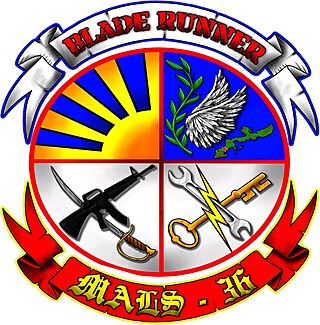
Marine Aviation Logistics Squadron 36 (MALS-36) is an aviation logistics support unit of the United States Marine Corps. Nicknamed Bladerunner, they are currently based at Marine Corps Air Station Futenma, Okinawa, Japan and fall under the command of Marine Aircraft Group 36 (MAG-36) and the 1st Marine Aircraft Wing.

Marine Air Control Group 28 (MACG-28) is a United States Marine Corps aviation command and control unit based at Marine Corps Air Station Cherry Point that is currently composed of four command and control squadrons and a low altitude air defense battalion that provide the 2nd Marine Aircraft Wing with airspace coordination, air control, immediate air support, fires integration, air traffic control (ATC), radar surveillance, aviation combat element (ACE) communications support, and an integrated ACE command post in support of the II Marine Expeditionary Force.

The Marine Aviation Logistics Squadron 16 (MALS-16) is an aviation logistics support unit of the United States Marine Corps. Known as the Immortals, they are currently based at Marine Corps Air Station Miramar and fall under the command of Marine Aircraft Group 16 (MAG-16) and the 3rd Marine Aircraft Wing.
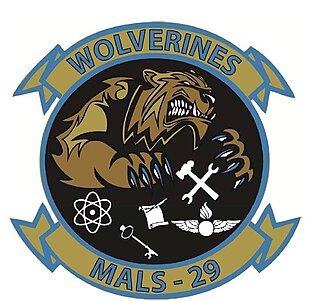
Marine Aviation Logistics Squadron 29 (MALS-29) was an aviation logistics support unit of the United States Marine Corps. Known as the "Wolverines", they fell under the command of Marine Aircraft Group 29 and the 2nd Marine Aircraft Wing and were based at Marine Corps Air Station New River. MALS 29 supported multiple types of aircraft and provided detachments to aviation combat elements operating globally in support of the United States National Defense Strategy.
Marine Aviation Logistics Squadron 31 (MALS-31) is an aviation logistics support unit of the United States Marine Corps. Known as the "Stingers", they fall under the command of Marine Aircraft Group 31 (MAG-31) and 2nd Marine Aircraft Wing and are currently based at Marine Corps Air Station Beaufort.
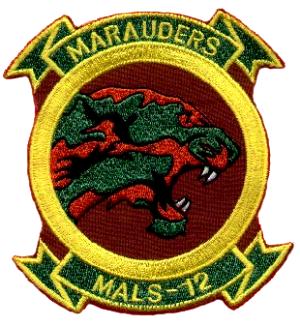
Marine Aviation Logistics Squadron 12 (MALS-12) is an aviation logistics support unit of the United States Marine Corps. Known as the "Marauders", they fall under the command of Marine Aircraft Group 12 (MAG-12) and the 1st Marine Aircraft Wing and are currently based at Marine Corps Air Station Iwakuni.
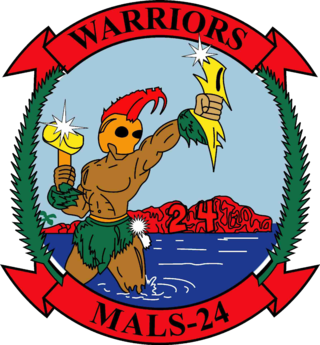
Marine Aviation Logistics Squadron 24 (MALS-24) is an aviation logistics support unit of the United States Marine Corps. Known as the "Warriors", they fall under the command of Marine Aircraft Group 24 (MAG-24) and the 1st Marine Aircraft Wing and are currently based at Marine Corps Base Hawaii.
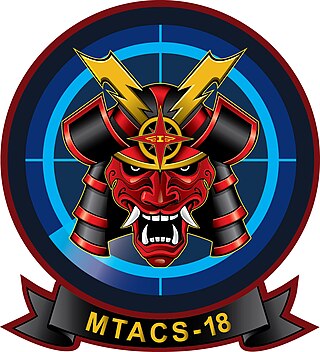
Marine Tactical Air Command Squadron 18 (MTACS-18) was a United States Marine Corps aviation command and control unit based at Marine Corps Air Station Futenma. The squadron provided the 1st Marine Aircraft Wings tactical headquarters and command post while deployed. MTACS-18 fell under the command of Marine Air Control Group 18 (MACG-18) and 1st MAW. The squadron was decommissioned on 9 June 2021 as part of the service's Force Design 2030. Responsibility for establishing 1st MAW's TACC now resides with the MACG-18 headquarters.

The United States Marine Corps is organized within the Department of the Navy, which is led by the Secretary of the Navy (SECNAV). The most senior Marine commissioned officer is the Commandant of the Marine Corps, responsible for organizing, recruiting, training, and equipping the Marine Corps so that it is ready for operation under the command of the unified combatant commanders. The Marine Corps is organized into four principal subdivisions: Headquarters Marine Corps, the Operating Forces, the Supporting Establishment, and the Marine Forces Reserve.

Marine Aviation Logistics Squadron 26 (MALS-26) is an aviation logistics support unit of the United States Marine Corps. They are currently based at Marine Corps Air Station New River, North Carolina and fall under the command of Marine Aircraft Group 26 and the 2nd Marine Aircraft Wing.

Marine Corps Air Station Camp Pendleton or MCAS Camp Pendleton is a United States Marine Corps airfield located within Marine Corps Base Camp Pendleton. It was commissioned in 1942 and is currently home to Marine Aircraft Group 39. The airfield is also known as Munn Field in honor of Lieutenant General John C. "Toby" Munn, the first Marine aviator to serve as the Commanding General of Marine Corps Base Camp Pendleton.

The United States Marine Corps Aviation (USMCA) is the aircraft arm of the United States Marine Corps. Aviation units within the Marine Corps are assigned to support the Marine Air-Ground Task Force, as the aviation combat element, by providing six functions: assault support, antiair warfare, close air support, electronic warfare, control of aircraft and missiles, and aerial reconnaissance. The Corps operates rotary-wing, tiltrotor, and fixed-wing aircraft mainly to provide transport and close air support to its ground forces. Other aircraft types are also used in a variety of support and special-purpose roles. All Marine Corps aviation falls under the influence of the Deputy Commandant for Aviation, whose job is to advise the Commandant of the Marine Corps in all matters relating to aviation, especially acquisition of new assets, conversions of current aircraft, maintenance, operation, and command.

A squadron in an air force, or naval or army aviation service, is a unit comprising a number of military aircraft and their aircrews, usually of the same type, typically with 12 to 24 aircraft, sometimes divided into three or four flights, depending on aircraft type and air force.

Marine Medium Tiltrotor Squadron 363 (VMM-363) is a United States Marine Corps tiltrotor squadron consisting of MV-22B Ospreys. The squadron, known as the "Lucky Red Lions", is based at MCB Hawaii and falls under the command of Marine Aircraft Group 24 (MAG-24) and the 1st Marine Aircraft Wing.

Marine Tactical Air Command Squadron 48 (MTACS-48) is a reserve aviation command and control unit of the United States Marine Corps based at Naval Station Great Lakes, Illinois. The squadron provides personnel and equipment for establishing the 4th Marine Aircraft Wings tactical headquarters and command post. It currently falls under the command of Marine Air Control Group 48 and is the last active MTACS in the Marine Corps due to reorganization as part of Force Design 2030.